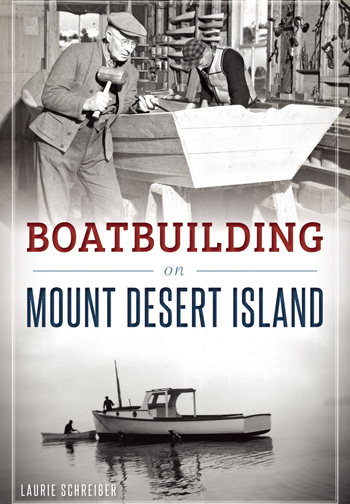B O O K R E V I E W
Conversations With Boatbuilders
by Eva Murray

Boatbuilding on Mount Desert Island
By Laurie Schreiber
158 pp., History Press, $21.99
When my brother was a teenager, he worked in a couple of the boatyards along the Georges River in Thomaston – first for Erik Lie-Nielsen, and then for the Newbert and Wallace yard. This would have been in the early 1980’s; hardly the Great Depression, but life was not awfully refined in Rockland in those days, and little brother’s own fortunes were not prosperous. He decided to leave school and go to work, and to trade in the lessons of the classroom for the lessons taught by old men with older tools. He got from those boatyards an enduring education, and speaks with great respect for those wooden-boat men, his mentors, and still remarks on the beauty of the Tioga and the Columbia. When he turned 51 this summer, I thought my brother might enjoy a gift of Laurie Schreiber’s book.
I believe I’ll be giving this book to a number of people, as it turns out. You don’t have to know a lot about boats to enjoy it.
Boatbuilding on Mount Desert Island reads like a conversation with a friend. There ought to be a cup of coffee at your elbow, a “mug up,” as it were. Schreiber’s accounts of the people – for this book is mostly about the people – who designed and built boats on and around Mount Desert in the earlier part of the 20th century are relaxed and intimate, as the builders and their descendants tell stories about each other. Their observations, and memories of daily life in those days a few decades back, make it a fun read even for those not particularly concerned with the details of who built what. If the reader has any background at all in Maine-built boats, or knowledge of the MDI area, or a general interest in Maine or maritime history, they may well find themselves carrying on a mental dialogue with this book. When the oldest remaining boat known to be built at the Bobby Rich’s Bass Harbor Boat Company was mentioned, I thought to myself, “Oh, sure, the Bajupa! Think I remember reading somewhere that the name comes from three girls, “Barbara, June, and Pat,” or something like that. The lobster buyer on Matinicus has her now. Rolls something awful, or at least she used to; first boat I ever got seasick off…”
When naval architect and sailboat designer Cyrus Hamlin was first mentioned, it was, “Oh yeah, Cyrus Hamlin! I know his son Jim; he was good friends with my husband when they were rail-fan teenagers working at the Trolley Museum down to Kennebunk…”
Of course, those won’t be precisely your responses as you read. You’ll pick up on some other name, some other boat, another random detail, but many readers will likely find themselves so engaged. You don’t study this little book of Maine-coast history; you interact with it.
The craft of boatbuilding
is a
neighborhood,
and a culture, and
a brotherhood
in a sense.
Schreiber’s work is not an academic exercise in armchair anthropology, nor is this a reference book where you will hunt and squint to look up the origin of your own particular vessel. There are no lists of hulls turned out by year or by yard, no attempts at a database, no blurry reprints of handwritten ledgers. Presumably due to the interconnectedness of the people and places – for the craft of boatbuilding is a neighborhood, and a culture, and a brotherhood in a sense – Schreiber’s history is less about timelines and records than about anecdotes. We get the nicknames, the family reminiscences, and the occasional bits of humor. There are warm accounts of fathers and sons, brothers, sweethearts, and four-year-old Lydia Butler who “was allowed to sail a little catboat all by myself.” We meet people who left MIT and Harvard to work in boatyards, and 1920’s kids who could build an admirable boat before they were fifteen. There are family tales aplenty, including of Henry Hinckley (yes, that Hinckley,) described as “a crusty old coot” and “crazy like a genius” and how during the early days of experimenting with fiberglass resin recipes he managed to get himself firmly glued down to his chair (doing “seat of the pants, incendiary lab experiments.”)
The photographs are the making of this book. Clear, helpful, and worth a second look, they offer us more than just calendar shots of pretty boats. Some of the photographs remind us of the rural Maine of our grandparents. Some, like a detailed shot from the deck of the Bonaventure while still under construction in Southwest Harbor in 1942, ask us to slow down and take a moment, to move into the scene for a few seconds and look around, which for the history buff or the wooden boat lover is a pleasant moment to spend. I particularly like the shop interior photographs and images of half-built vessels with their builders and their tools.
The MDI boatbuilding story is truly a story of families – beginning with the Riches of Richtown and including the Hinckleys, the Stanleys, and others – and we, the readers, are welcomed to their tables, or to stand around in the back of the boat shop and listen. You can practically smell the wood (and, eventually, the fiberglass). You can imagine master builder Sim Davis, after his retirement, “playing guitar and singing songs on the CB.”
